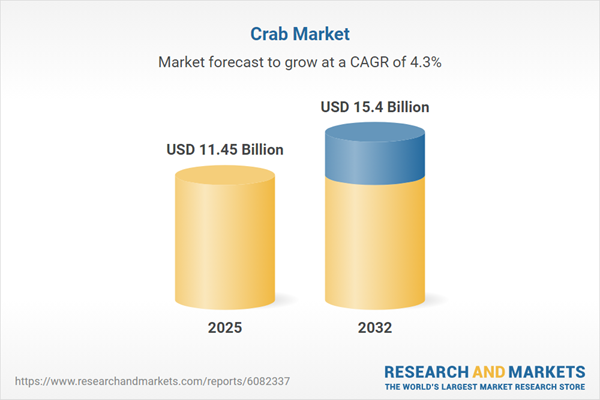Speak directly to the analyst to clarify any post sales queries you may have.
The global crab market is experiencing significant transformation, compelling senior decision-makers to adapt to shifting consumer preferences, a dynamic regulatory environment, and advances in traceability technology. Strategic responses are required to balance sustainable practices and operational efficiency.
Market Snapshot: Crab Market Size, Growth, and Forecast
The Crab Market is expanding steadily, valued at USD 11.01 billion in 2024 and advancing to USD 11.45 billion in 2025. Projections indicate the market will maintain a 4.28% CAGR, reaching USD 15.40 billion by 2032.
This positive outlook is driven by innovations in supply chain logistics, along with increased consumer demand for products that offer both ethical sourcing and traceability. As regulatory landscapes evolve and buyers become more discerning, stakeholders are compelled to refine their sourcing models and distribution frameworks to capture emerging opportunities.Scope & Segmentation
- Crab Species Types: Covers estuarine, freshwater, and marine species meeting a wide range of market requirements.
- Product Categories: Includes canned, fresh, and frozen crab to support varied retail and wholesale distribution approaches.
- Product Forms: Offers crab in meat, paste, and whole forms suitable for retail, foodservice, and industrial customers.
- Distribution Channels: Features offline options such as supermarkets, hypermarkets, and convenience stores, alongside the growth of online retail platforms facilitating broader reach.
- End Uses: Serves food and beverage (households, hotels, restaurants, catering), the cosmetic industry (haircare, skincare), and pharmaceutical manufacturing.
- Regional Markets: Encompasses both established and emerging regions, such as the Americas (notably the United States, Canada, Brazil), Europe, the Middle East & Africa (including the UK, Germany, UAE, South Africa), and Asia-Pacific (featuring China, India, Japan, Australia, and others). Distinct consumer demand and regulatory standards characterize each region.
- Key Companies: Leading industry players consist of Aqua Star Corp., Bumble Bee Foods, Clearwater Seafoods, High Liner Foods, JM Clayton Seafood, KEYPORT LLC, Maine Lobster Now, Maruha Nichiro, Mazzetta Company, Millennium Ocean Star, Ocean Choice International, Ocean More Foods, Pacific Cove, Pacific Seafood, Phil-Union Frozen Foods, Phillips Foods, PT. Crab Processor Indonesia, SEA DELIGHT, Seaview Crab Co., Shanghai Fisheries, Sogelco International, Stavis Seafoods, Supreme Crab and Seafood, Thai Union Group, Trident Seafoods, and Young's Seafood Limited.
- Enabling Technologies: Advances such as cold-chain monitoring, blockchain-based traceability, packaging solutions, and digital marketplaces are being utilized to uphold product quality, enhance transparency, and drive process optimization.
Key Takeaways
- Sustainability is paramount as market leaders and regulatory agencies set new standards around ethical sourcing, requiring supply chains to regularly upgrade compliance protocols.
- Adoption of traceability tools such as blockchain and digital tagging is creating benchmarks for transparency, with supply partners expected to provide detailed sourcing intelligence.
- Changing consumer preferences are accelerating growth of value-added and specialty crab products, prompting brands to diversify offerings for both retail and foodservice segments.
- The retail landscape is evolving toward an omnichannel approach, as businesses balance in-store presence with expansion into online platforms, direct-to-consumer services, and subscription models to attract and retain clients.
- Cross-sector collaboration among producers, research institutions, and end users in the cosmetics and pharmaceuticals sectors is fostering new product development and diversifying revenue streams.
Tariff Impact on Supply Chain and Trade Flows
Recent post-2025 tariff adjustments in the United States are causing realignment across international crab trade networks. Exporters are streamlining logistics to reduce rising costs, exploring alternative routes, and seeking growth in new markets. Meanwhile, importers are expanding their supplier base and forging industry partnerships to counteract unpredictability and maintain competitive positioning in response to tariff-driven volatility.
Methodology & Data Sources
The research methodology applies a multi-source framework—integrating regulatory filings, academic studies, industry datasets, and firsthand insights obtained through structured interviews. Findings are validated using triangulation and expert panel review to ensure comprehensive and balanced coverage.
Why This Report Matters
- Supports senior leaders in developing resilient business strategies by delivering updated intelligence on market segmentation, regulatory changes, and enabling technologies in the crab market.
- Enables benchmarking of sustainability, logistics, and innovation investments against peer initiatives and evolving industry standards, providing actionable insights for regulatory adaptation.
Conclusion
Senior executives can leverage the insights contained in this report to proactively align operational objectives with emerging trends and evolving demands within the crab market, ensuring strategic success.
Table of Contents
3. Executive Summary
4. Market Overview
7. Cumulative Impact of Artificial Intelligence 2025
Companies Mentioned
The companies profiled in this Crab market report include:- Aqua Star Corp.
- Bumble Bee Foods, LLC
- Clearwater Seafoods Incorporated
- High Liner Foods Incorporated
- JM Clayton Seafood Company
- KEYPORT LLC
- Maine Lobster Now LLC
- Maruha Nichiro Corporation
- Mazzetta Company, LLC
- Millennium Ocean Star Corporation
- Ocean Choice International L.P.
- Ocean More Foods Co., Limited
- Pacific Cove
- Pacific Seafood Group
- Phil-Union Frozen Foods Inc.
- Phillips Foods, Inc.
- PT. Crab Processor Indonesia
- SEA DELIGHT LLC
- Seaview Crab Co.
- Shanghai Fisheries General Corporation
- Sogelco International Inc.
- Stavis Seafoods
- Supreme Crab and Seafood Inc.
- Thai Union Group PLC
- Trident Seafoods Corporation
- Young's Seafood Limited
Table Information
| Report Attribute | Details |
|---|---|
| No. of Pages | 182 |
| Published | November 2025 |
| Forecast Period | 2025 - 2032 |
| Estimated Market Value ( USD | $ 11.45 Billion |
| Forecasted Market Value ( USD | $ 15.4 Billion |
| Compound Annual Growth Rate | 4.2% |
| Regions Covered | Global |
| No. of Companies Mentioned | 27 |









